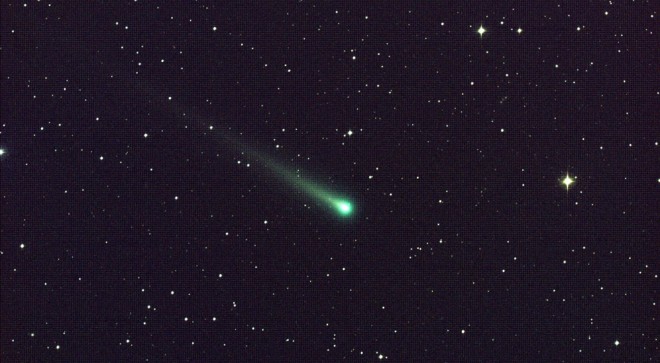Will comet ISON survive its near brush with the Sun?

In this photo provided by NASA, Comet ISON shines in this five-minute exposure taken at NASA’s Marshall Space Flight Center on Nov. 8 at 5:40 a.m. EST. At the time of this picture, Comet ISON was 97 million miles from Earth, heading toward a close encounter with the sun on Nov. 28. Located in the constellation of Virgo, it is now visible in a good pair of binoculars. AP
WASHINGTON—US astrophysicists are split over what will happen when the comet ISON passes near the sun Thursday, but a majority think it will break apart.
Comets are frozen balls of space dust left over from the formation of stars and planets billions of years ago.
So when one of them zips close to a hot star, like the Sun, sometimes the icy core . . . melts.
“Many of us think it could break up into pieces, and some people think it won’t survive at all” after its brush near the Sun, said comet expert Carey Lisse of the Johns Hopkins Applied Physics Laboratory during a telephone press conference.
But he conceded, there are others who think the icy mass “will actually survive and come back out” on the other side of the sun, albeit somewhat shrunken down from its encounter with the Sun’s heat.
Article continues after this advertisementISON will be just 1.17 million kilometers (727,000 miles) from the sun as it passes by where it will be hit by temperatures of around 2,700 degrees Celsius (4,900 Fahrenheit).
Article continues after this advertisement“I think it has a, maybe, 30 percent chance to make it” past the sun intact, Lisse said.
The comet “is like a loose snow ball,” he explained, saying it is “maybe half or a third water and it’s rather weak.” It’s also smaller than most comets, currently measuring around 1.2 kilometers in diameter.
“The average size for a comet is about three kilometers diameter, so this comet is maybe about half the size of the average, typical comet,” he said.
Either way it turns out, astronomers are watching keenly.
“We have never seen a comet like this coming from the Oort cloud and going in the sun grazing orbit,” said astrophysicist Karl Battams, of the Naval Research Laboratory in Washington.
We “don’t really have any past experience we can use to judge or predict what is going to happen to this one,” he said, adding it’s “a very peculiar object but also a fascinating object.”
Scientists say the comet comes from the very origin of the solar system, 4.5 billion years ago—preserved “in deep freeze in the Oort cloud halfway to the next star for the last four and a half billion years,” Lisse said.
If ISON survives its passage near the Sun, it will be visible at night from December through February, crossing nearest Earth—about 64 million kilometers away on December 26.
The US space agency is gathering a round table of astronomers on Thursday starting at 1700 GMT to answer questions from the public and from the scientific community as they follow the comet’s brush with the Sun.